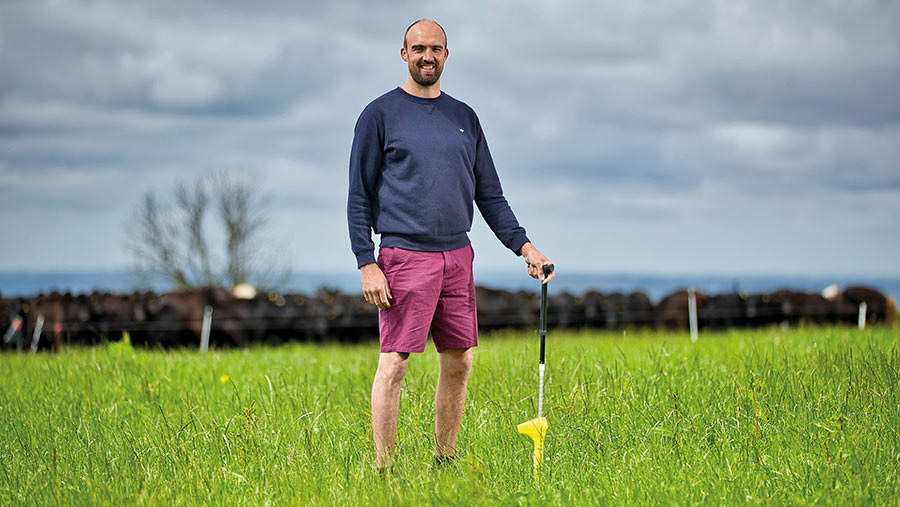How graziers aim to keep fertiliser cost below £40/ha
 Aled Evans © Richard-Stanton
Aled Evans © Richard-Stanton Brothers Aled and Iwan Evans, and Llifon Davies, have used rotational grazing and legumes to achieve a dairy farm’s stocking rate for a beef farm’s fertiliser cost.
The pair, who won Farmers Weekly Awards Beef Farmer of the Year 2021, hope to keep nitrogen costs at Rest Farm, near Carmarthen, below £40/ha, while running 1,540kg of liveweight/ha across the farm.
This should help keep the grass-based dairy-beef finishing system that runs alongside a low-input sheep enterprise firmly in profit.
See also: Little relief in sight on fertiliser supply and price
Several management decisions are intended to control this year’s fertiliser bill, explains Aled.
Recently, the farm has been using 35-40kg nitrogen/ha for growing silage and strategically on pasture to build covers at the shoulders of the season and in dry periods.
But Aled stresses their system is aiming to wean itself completely off fertiliser, as well as glyphosate, by 2027.
“So much of our fertiliser reduction comes from managing grass better and having the infrastructure in tracks, fencing and water troughs to allow us to graze,” he explains.
“Before the fertiliser markets altered drastically, we had cut nitrogen costs from £41/ha to £28/ha, while bought-in feed demand reduced 75%.”
Aled has put in place four steps to minimise fertiliser cost to about £8,000 across 212ha (524 acres) this year. This is for 10.2t of granular and 1500l of foliar feed.
Farm facts
- 650 dairy-cross cattle grazing a year
- 700 Romney ewes
- 212ha (524 acres)
- 325 cattle finished annually
- Weekly grass measuring
- 50 hours a week/labour unit
- Grows 12-14t dry matter/ha of grass
1. Drop store lambs to manage risk
A profit-sharing store lamb enterprise took a break this winter to ensure better grass availability in the spring and more leaf to help early growth.
One of the strategic uses of fertiliser is to jump-start grass in February and March at the start of the grazing season.
By limiting the stock pressure through autumn and winter, the farm left 2,200-2,400kg dry matter (DM)/ha, which was more than 2,500kg DM/ha in February.
Each year the farm takes in as many store lambs as it can graze and then winters on turnips. Last year it was about 750 head.
“We decided the store lamb gamble was quite high risk for the return and would probably just see us buying in more fertiliser with any profit,” explains Aled.
The decision seems to have paid off, with much of the winter being mild and a winter housing period of 75 days – about two weeks shorter than the 90- to 100-day target.
“Getting out for an early grazing round when growth is at 6-7kg DM/ha/day increases growth, as it jumps to 15-20kg DM after you’ve grazed it,” he says.
Instead of lambs the business took in an extra batch of dairy calves in October and reared them up to 120kg in the climate-controlled shed to make the asset “sweat”.
2. Farming for improved soil health to lower inputs
The team is learning more and more about the farm’s soils, starting with chemical measurements and increasingly looking at physical properties.
Standard soil tests have kept the farm at phosphate (P) and potassium (K) indices of 2 and 3, with P and K always added with ground lime (up to 5t/ha [2t/acre]).
Lime has maintained pH at 6-6.5, which ensures the soil is able to use the nitrogen when it is applied.
With nitrogen being so expensive last year, lime cost increased, but only by £2.50/t (spread) to £33/t, says Aled.
A soil structure test devised by soil and grassland adviser Niels Corfield has been used to track:
- Infiltration rates (which vary from 11sec to 40min)
- Worm counts
- Slake test – how soil holds together under water
- Soil structure assessment
- Organic matter (7.5-9.2%).
The big change in the past year or so has been to experiment with longer rotations (30-40 days as opposed to 18-25 days). Slightly longer covers of about 3,000kg DM/ha help to slow the passage of feed through the cattle and also grow deeper rooting systems, says Aled.
“If we have healthier soils full of life and worms, and with deeper roots, the effect of drought will be reduced. The soils will be more resilient to it, as there will be less run-off from the last rain, so there will be less need to add synthetic nitrogen when dry periods come.”
3. Fix nitrogen naturally
Clover is present in every field of the farm to varying degrees, fixing 180kg/ha or more atmospheric nitrogen annually.
Much of the clover has been direct-drilled after a Redstart/stubble turnip break crop, followed by a mix of high-sugar ryegrass, plantain and red and white clover.
Only 17ha (42 acres) can be currently classed as a “diverse ley” containing additional chicory, trefoil and other grasses. A further 10ha (25 acres) is being drilled this spring.
“The plan is to have 50% of the farm in diverse leys in a few years’ time,” says Aled. “We hope to eradicate bought-in nitrogen completely.”
About 20ha (49 acres) of ryegrass with 3kg of red clover are being farmed without synthetic nitrogen. The leys are used for silage and finishing lambs before being used for grazing.
Ewes are kept off these leys for the six weeks before and after tupping to avoid fertility issues. Stock is transitioned onto them for up to 10 days to avoid bloat/acidosis.
The entire farm is drilled and improved. Recent mixes have used about 14-15kg of seed/ha, of which 1.5kg is red clover, white clover and plantain. Timothy and high-sugar ryegrass are also included. Fields are only reseeded if growth drops below 12t DM/ha.
4. Test and maximise alternative products
About 1m litres of rainwater has been diverted from the slurry lagoon. This has increased the nitrogen content and manurial value of the slurry, but reduced overall volume.
This was done with a few checks to building gutters, down pipes and the installation of sleeping policemen in the yard earlier in the winter. Rainwater now goes into a culvert from the buildings and yard water is diverted into a clean ditch.
Future plans include rainwater harvesting for drinking water.
This spring, the plan for the silage ground – the fields with the highest nitrogen demand – is to do the following:
- If conditions allow in early March, apply 6,177.5gal/ha with a slurry injector
- Apply a “half rate” of granule nitrogen (ammonium nitrate 34.5%). This will be 15kg, rather than 30kg in mid- to late March
- Six weeks before first cut (mid-April), a foliar spray will be applied, combining sulphur Thio-S (5 litres/ha), foliar nitrogen MZ28 (20 litres/ha) and a carbohydrate boost (10 litres/ha) to improve the efficiency of the nitrogen conversion. It will include a humic acid to help nutrient mobilisation and will be applied by a local contract sprayer. The nitrogen costs about £37/ha for this application, but with the sulphur and others it will be more like £44/ha
- First cut will be taken from 15-20 May. Slurry will be injected after first cut and a similar process will follow for second cut.
Enter the 2022 Farmers Weekly Awards
 The 2022 Farmers Weekly Beef Farmer of the Year is sponsored by ABP.
The 2022 Farmers Weekly Beef Farmer of the Year is sponsored by ABP.
Join Farmers Weekly in celebrating the farming industry and recognising the hard work of UK farmers and enter the awards today.
Alternatively, nominate a deserving individual for an award.
For more information about the 2022 Farmers Weekly Awards, visit the official Farmers Weekly Awards website.
